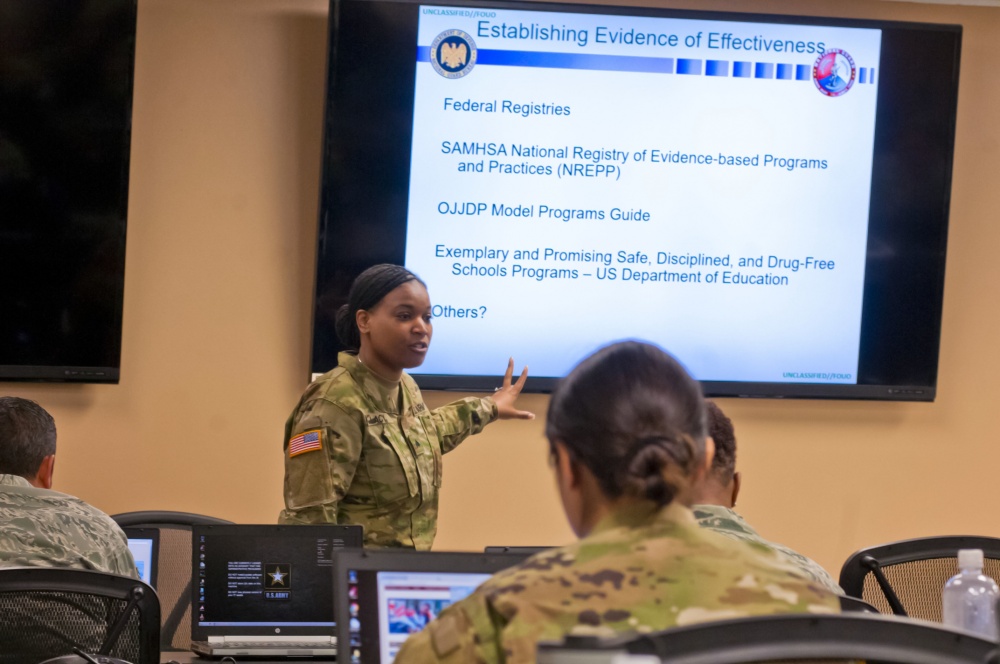 Photo By 1st Lt. Nadine Wiley De Moura | Sgt. Eilleen Lacy, NCOIC of Chicago Civil Operations instructs Texas National Guard criminal analysts on how to establish evidence of effectiveness when helping coalitions and CBOs create an action plan to address prevention of drug use at Camp Mabry, Austin, Texas, June 12-14,2018.
Photo By 1st Lt. Nadine Wiley De Moura | Sgt. Eilleen Lacy, NCOIC of Chicago Civil Operations instructs Texas National Guard criminal analysts on how to establish evidence of effectiveness when helping coalitions and CBOs create an action plan to address prevention of drug use at Camp Mabry, Austin, Texas, June 12-14,2018.
AUSTIN , TX, UNITED STATES
06.21.2018
Story by 1st Lt. Nadine Wiley De Moura
Texas Army National Guard (Texas Military Forces)
By: 1st Lt. Nadine Wiley De Moura, Texas Military Department
AUSTIN, Texas – Texas National Guard Counterdrug Criminal Analysts participated in a three-day in-depth overview of civil operations, led by Illinois National Guard Counterdrug Civil Operators, at Camp Mabry, June 12-14, 2018.
Soldiers and Airmen from all corners of Texas displayed pride for their home communities and eagerly sought advice from Illinois National Guard Civil Operators on how to best impact their area of operation.
“I would like people to begin to look at things through other lenses,” said Sgt. Eilleen Lacy, noncommissioned officer in charge of the Chicago Civil Operations. “Typically in the community and in counterdrug we look at disruption and interdiction from a criminal analyst perspective, but we need to start looking at this from a community level. We need to start taking community health and wellness into consideration.”
The role of a Civil Operator is to coach, train, facilitate, coordinate, lead and support coalitions and community-based organizations to make community change. This change directly impacts high-intensity drug trafficking areas, Lacy explained during the civil ops pre-training.
The 20 Soldiers and Airmen selected to attend the class work as criminal analysts in the Texas Counterdrug program and will take on the responsibility of being the Civil Operators in their area of operation as an additional duty.
“Knowing your area of operation, not just from a law enforcement standpoint, but from past pertinent history will help you get to the root or cause of the problem,” Lacy said.
Lacy, who shared her experiences as a Civil Operator in Chicago, encouraged participants to become familiar with their communities by learning who their community stakeholders are and capitalizing on local resources, like librarians.
“The more proficient Civil Operators are in their abilities to provide technical assistance in the planning process, the larger impact the coalitions will have in their community,” Lacy explained.
In addition to familiarizing themselves with the community, Soldiers and Airmen will implement resources by studying threats, trends and evidence-based data from organizations like the National Institute of Drug Abuse, Substance Abuse and Mental Health Services Administration, Center for Disease Control and Prevention as prescribed by the National Guard Bureau and the Department of Defense.
Soldiers and Airmen will also use SAMSHA’s Strategic Prevention Framework to help enable coalitions to tackle their mission from several fronts. The SPF is a seven-step process that includes: assessing the area of operation’s needs and readiness, building the capacity to realistically address the needs, planning, implementing, evaluating and ensuring cultural competence and sustainability.
The training also addressed other concepts, like methods of research, grant writing, prevention science, sustainability and culture compatibility.
Illinois National Guard Counterdrug didn’t hesitate to extend itself as an additional resource to the Texas National Guard Counterdrug program.
“Illinois [National Guard] has a very robust Civil Operations Program,” said Maj. David Spanton, Texas National Guard Civil Operations Program Manager. “Col. Miguel Torres [Texas National Guard Joint Counterdrug Task Force Commander] thought it was important to get the training to our Soldiers and Airmen as fast as possible, with the best subject matter experts, and Illinois was excited to help out Texans and start making a change immediately.”
The Illinois Guardsmen attributed their expertise in civil operations to their Counterdrug Commander, Capt. Alison Jacobs.
“She recognizes the mission and makes sure that she remains knowledgeable about policy, best practices and prevention,” Lacy said. “She recognizes that prevention is an important part of the mission and that we should be working simultaneously on both sides of that coin.”
Maj. Travis Urbanek, Texas Joint Counterdrug Task Force Region North Commander, and one of the Soldiers spearheading the statewide civil operations initiative in Texas, agreed with Jacobs’ sentiment.
“This will allow us to approach the drug issue from two fronts,” Urbanek said. “Right now, our approach has been attacking the drug issue from the law enforcement side, but as long as there continues to be a demand for drugs the suppliers will find ways to get them to people who want to buy it.”
Following the initial training, Soldiers and Airmen must pass two phases of training in order to qualify as civil operators and acquire their civil operations additional skill identifier.
Soldiers voiced their eagerness throughout the training to begin working in their respective communities.
Passionate and inspired by over a decade of volunteering for youth and community organizations herself, Lacy mirrored the group’s enthusiasm.
“It’s something that needs to be done on the community level,” Lacy added. “The way we look at civil operations and prevention is that if we do it right, we will do ourselves out of a job – and I accept that challenge.”
Story by: 1st Lt. Nadine Wiley De Moura, Texas Joint Counterdrug Task Force Public Affairs